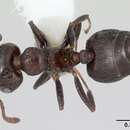en
names in breadcrumbs


Crematogaster crinosa is an extremely widespread and generalized species that prefers highly insolated habitats. It is common in seasonally dry areas, less common in wet forests. In wet forest habitats it is typically found in the high canopy or in disturbed areas. It may form monodominant populations in mangrove forests.
Colonies are large and polydomous and it is usually difficult to locate colony boundaries. Nests are found in almost any kind of cavity (figs. 1, 2, 4), and columns of workers move from nest to nest. Nests can be in live or dead branches, in small rotten knots, under bark flaps, in cavities in fence posts, opportunistically in ant plants, and thinly dispersed in multiple small bark cavities. Workers, brood, and alate sexuals are dispersed across nests. Small amounts of carton construction are used to form baffles inside of nest cavities and to restrict nest entrances, but large external carton nests are never constructed.
Although new alate queens are relatively common in nests, I have rarely encountered physogastric colony queens. In my collecting experience, I have never found a colony that was obviously polygynous, with many dealate queens dispersed in many nests. However, I am treating Forel's minutior as a synonym of crinosa, and minutior from St. Vincent Island in the West Indies forms large polygynous, polydomous colonies in coastal areas (Forel 1893).
In Colombia I observed the beginning of a nuptial flight just after dusk. I found a dense aggregation of males and workers under a bark flap, and the males were just beginning to fly.
Workers are omnivorous. They are attracted to protein and carbohydrate baits, they scavenge dead or injured insects, they visit extrafloral nectaries, and they tend Homoptera. When nests are disturbed they can be aggressive and will bite. Workers are continuously polymorphic, with a broad range of worker sizes.
I often find cockroach egg cases scattered in the nest chambers of C. crinosa (fig. 1), at a much higher density than in the environment generally. The nature of the relationship between cockroaches and the crinosa group would be worth investigation.
Ecological equivalents are torosa and rochai. I can detect very few behavioral or ecological differences among these species. Crematogaster crinosa is the only member of the group that regularly dominates mangrove habitats. Mangrove forests in Costa Rica are sometimes dominated by Azteca, sometimes by C. crinosa. I found a similar situation in the Santa Marta area of Colombia. I have only one record of rochai from mangroves (a voucher collection from Adams' studies of mangrove communities, Adams 1994), and I have no record of torosa from mangroves. Other than in mangroves, crinosa is less abundant relative to torosa or rochai. For example, a collecting trip to a wildlife refuge in southern Texas yielded 13 separate collections of torosa but only one of crinosa. In northwestern Costa Rica, torosa and rochai are far more abundant than crinosa. Based on museum collections, crinosa seems to be the most common member of the crinosa group on various Caribbean and Pacific islands.
Throughout the Neotropics, from southern Texas to Argentina and on numerous Caribbean islands.
Taxonomic history
Mayr, 1887 PDF: 627 (q.m.).Combination in Crematogaster (Orthocrema): Emery, 1922c PDF: 134.Combination in Crematogaster (Orthocrema): Blaimer, 2012c PDF: 55.Senior synonym of Crematogaster brevispinosa, Crematogaster chathamensis, Crematogaster minutior, Crematogaster recurvispina, Crematogaster sampaioi, Crematogaster schuppi, Crematogaster striatinota, Crematogaster townsendi and material of the unavailable name Crematogaster semisericea referred here: Longino, 2003a PDF: 49.